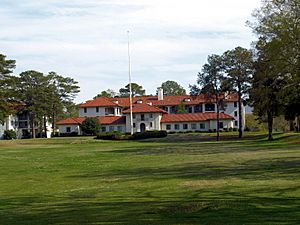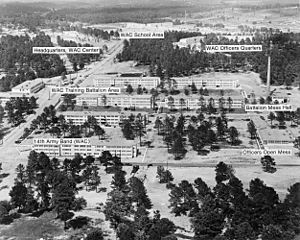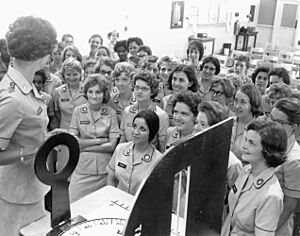Fort McClellan facts for kids
Fort McClellan, which was first called Camp McClellan, was a big United States Army base near Anniston, Alabama. During World War II, it was one of the largest Army training centers. About half a million soldiers trained there. After the war, it became home to important Army schools. These included the Military Police Corps, the Chemical Corps, and the Women's Army Corps.
From 1975 until it closed in 1999, Fort McClellan was the main place for Military Police training. It also housed the Chemical Corps School, which taught soldiers about chemical warfare defense. In 1988, it was even used to train United States Border Patrol agents. Before it closed, about 10,000 military people and 1,500 civilians worked there. After its closure, the land was cleaned up. Since 2010, parts of the old base have become a new community. Other parts are still used by the Alabama Army National Guard for training.
Contents
Early History of Fort McClellan
The area where Fort McClellan was built has an interesting past. It is located in the Choccolocco Foothills of the Appalachian Mountains.
Camp Shipp: Spanish–American War Era
Even before Fort McClellan, there was a temporary Army camp here called Camp Shipp. It was set up in August 1898 during the Spanish–American War. The Army needed a place for reserve soldiers from Alabama. Anniston was a good spot because it had a railroad line going to Mobile, Alabama, which was a major port for ships heading to Cuba.
By October 1898, nearly 10,000 troops were at Camp Shipp. But the war ended quickly, and the camp was closed by March 1899. It was also used as a hospital for soldiers who got sick. The camp was named after Lt. William E. Shipp, a brave soldier who died in Cuba.
Camp McClellan: World War I Training
In 1912, people became interested again in having an Army training base near Anniston. The area's mountains were perfect for artillery training. So, 20,000 National Guardsmen came for practice. Army leaders liked the land and suggested the government buy it.
On March 17, 1917, the government bought about 18,952 acres (76.7 km²) of land. Soon after, on April 6, 1917, the United States declared war on Germany, starting World War I. Camp McClellan was officially created on July 18, 1917. It was named after Major General George B. McClellan, a famous Civil War general. Camp McClellan was one of 32 camps built to quickly train soldiers for the war.
The camp had many temporary wooden buildings for offices, dining halls, and showers. Soldiers lived in tents with wooden floors. About 1,500 buildings were put up, including a large hospital. The first troops arrived in August 1917. By October, over 27,000 men were training there. They came from states like New Jersey, Virginia, and Maryland.
Fort McClellan: A Permanent Army Post
After World War I ended in 1918, most temporary training camps closed. But Camp McClellan was kept open for special training. In 1926, Congress approved money to build permanent facilities. New buildings for headquarters, officer homes, barracks, and a hospital were started. On July 1, 1929, the camp officially became a permanent base called Fort McClellan. It was meant to house one infantry regiment and train thousands of civilian trainees in the summer.
During the Great Depression, President Franklin D. Roosevelt used special funds from the Works Progress Administration (WPA) to continue construction at Fort McClellan. Between 1933 and 1936, about $1.7 million was used to build new roads, an airfield, and more permanent buildings. Many of these buildings were built in the beautiful Spanish Colonial Revival architecture style.
In the 1930s, the Army's 22nd Infantry Regiment was stationed at Fort McClellan. They trained units from the Reserve Officer Training Corps (ROTC) and the United States Army Reserve. They also hosted the annual summer camp for the Alabama Army National Guard.
Fort McClellan in World War II
As World War II began, Fort McClellan grew much larger. While the main permanent buildings stayed, many new temporary wooden buildings were added. All the old buildings from World War I were also updated. In October 1940, the 27th Infantry Division from New York arrived. Most of these soldiers lived in tents until they left for the war in December 1941. They were sent to fight in the Pacific.
Major Expansion for the War (1941–1944)
The government spent about $6.5 million to expand Fort McClellan. This allowed it to house up to 50,000 soldiers. Improvements included 74 miles (118 km) of new roads and a sewage system for 50,000 people. A huge general hospital with 80 wooden buildings was built. There were also five theaters, an amphitheater for 12,000 people, and many warehouses. Hundreds of small huts were built for the soldiers in training.
The land area of Fort McClellan also got much bigger. Land to the east was added, giving access to the Talladega National Forest for training. This made the base a total of 42,286 acres (169.1 km²). A few miles to the west, another 22,168 acres (86.7 km²) were bought for artillery and tank training. This area was called Pelham Range.
At its busiest, Fort McClellan had 2,170 officers and 42,126 enlisted soldiers. During the war years, almost 500,000 men trained at Fort McClellan.
Basic and Special Training
In 1942, Fort McClellan started training new recruits and draftees. This was called the Branch Immaterial Training Center. Recruits received eight weeks of basic training. Then they were sent to other places for combat training or special schools. In 1943, this became the Infantry Replacement Training Center (IRTC). Under IRTC, basic training increased to nine weeks. It included realistic combat situations, like training in fake towns and practicing in foxholes while tanks moved overhead.
Fort McClellan also trained special troops. This included the 92nd Infantry Division, made up of African-American soldiers from all over the country. The 92nd Division trained in 1942–1943. Then they went overseas to fight in Italy.
Prisoner of War Camp
During World War II, Fort McClellan also became a temporary home for many captured enemy soldiers. A camp for 3,000 prisoners of war (POWs) was built in 1943. This camp also received prisoners who would then go to three other POW camps in Alabama. At the end of the war in Europe, the camp at Fort McClellan held 2,546 men. There is a cemetery on the base that marks where 26 German and 3 Italian prisoners of war who died in captivity are buried.
After World War II
After World War II ended, Fort McClellan continued to train soldiers for occupation duty until November 1946. Then, the number of soldiers training there quickly dropped. The base was made inactive on June 30, 1947, with only a small maintenance crew left.
However, with the start of the Korean War in June 1950, plans to use the base again sped up. Fort McClellan was officially reactivated in 1951. Its new missions included training the National Guard and operating the Chemical Corps training center.
Chemical Corps Training
Money was given to build special facilities at Fort McClellan for the Chemical Corps School (CCS). In 1952, the CCS began its work. The school taught soldiers about chemical warfare defense. This included eight weeks of basic training followed by eight weeks focused on chemical warfare.
In September 1953, a secret operation called Operation Top Hat happened at the CCS. During this, Chemical Corps personnel tested ways to clean up after biological and chemical weapons.
In 1979, the U.S. Army Chemical School (ACS) moved back to Fort McClellan. The ACS offered many courses for officers and soldiers. These courses ranged from general topics to very technical ones. Soldiers from other countries also came to train at the school. When the base closed in 1999, the Chemical School moved to Fort Leonard Wood, Missouri.
Military Police Corps Training
The Military Police Corps is one of the newer branches of the U.S. Army. It was officially created in September 1941. The Military Police School moved to Fort McClellan on July 11, 1975.
The Military Police School taught soldiers about general policing, managing prisons, and security. It also ran the Department of Defense Polygraph Institute. The Military Police School also moved to Fort Leonard Wood, Missouri, in 1999.
Women's Army Corps Training
The Women's Army Corps (WAC) was the women's branch of the U.S. Army. It was created in 1942. The Women's Army Corps School started at Fort McClellan on September 25, 1952.
About two years later, Fort McClellan became the first permanent home of the U.S. Women's Army Corps Center (WACC). The WAC handled the arrival, processing, and training of all female officers and enlisted personnel joining the Army. Fort McClellan was its home until the Corps was closed in 1978. Major General Mary E. Clarke, the last director of the Women's Army Corps, became the Commanding General of Fort McClellan in 1978. She was the first female officer to command a major U.S. Army base.
Vietnam War Training
In 1966, to help with the Vietnam War, an Advanced Individual Training Infantry Brigade was started at Fort McClellan. The Fort was renamed the U.S. Army School/Training Center and Fort McClellan. In 1969, with this Training Brigade, the Women's Army Corps Center, and the Army Chemical School, Fort McClellan was the only U.S. Army base with three major training missions.
After training more than 30,000 men, the Training Infantry Brigade was closed in April 1970 as forces in Vietnam were reduced.
US Border Patrol Training
In 1986, a law allowed the hiring of 500 more United States Border Patrol Agents. The original Border Patrol academy was too small. So, a satellite academy was built at Fort McClellan. The 226th class of Border Patrol basic training used this new academy. Even though there were plans for more classes, the Border Patrol never returned to Fort McClellan for training.
Closing and Present Use
In its last decades, Fort McClellan was home to about 10,000 military people. About 5,000 of them were permanently assigned there. The base also employed about 1,500 civilians.
In 1995, the Base Realignment and Closure (BRAC) Commission decided to close Fort McClellan permanently. No new troops were sent there after 1995, except for basic training, the chemical school, and the MP school. The official closing ceremony was held on May 20, 1999. Major General Ralph G. Wooten, the Commanding General at the time, thanked Fort McClellan and the local communities. He said the base had done an excellent job training America's soldiers for over 81 years.
When it closed, Fort McClellan was home to the U.S. Army Chemical School, the U.S. Army Military Police School, the Training Brigade, and the Department of Defense Polygraph Institute. The Chemical School, Military Police School, and Training Brigade all moved to Fort Leonard Wood, Missouri. The Polygraph Institute moved to Fort Jackson, South Carolina.
Military and Government Use Today
A part of Fort McClellan is still used by the Alabama National Guard. It is called the Fort McClellan Army National Guard Training Center. It is also home to the Alabama National Guard Officer Candidate School. The AAFES still runs a store there. Fort McClellan also hosts the Center for Domestic Preparedness (CDP) for the Department of Homeland Security.
McClellan Community Development
After the base closed, local leaders worked to redevelop Fort McClellan. In March 2010, the McClellan Development Authority was created. Its job is to manage the economic development of the former fort. In 2014, after 11 years, the environmental cleanup of the land was finished. By September 2015, over 3,100 acres were back in use.
McClellan is now a 10,000-acre (40.0 km²) planned community. It has areas for homes, businesses, industries, stores, and education. Since it opened, McClellan has become home to over 900 residents and a workplace for more than 3,000 employees.
Mountain Longleaf National Wildlife Refuge
In 2003, the U.S. Fish and Wildlife Service created the Mountain Longleaf National Wildlife Refuge. It covers 9,016 acres (36.1 km²) of undeveloped land from the former Fort McClellan. It is named after the rare mountain longleaf pine forests found there.
This wildlife refuge is still new, so it does not have many tourist facilities yet. Some parts of the reserve are closed to the public while environmental cleanup continues. However, there are limited chances for hiking, photography, and watching wildlife. Work is ongoing to restore the environment from the effects of the Army's long use of the area.
Images for kids







